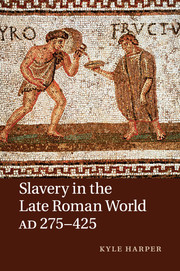Book contents
- Frontmatter
- Contents
- List of tables
- Acknowledgments
- PART I THE ECONOMY OF SLAVERY
- Introduction
- 1 Among slave systems: a profile of late Roman slavery
- 2 The endless river: the supply and trade of slaves
- 3 Oikonomia: households, consumption, and production
- 4 Agricultural slavery: exchange, institutions, estates
- PART II THE MAKING OF HONORABLE SOCIETY
- PART III THE IMPERIAL ORDER
- CONCLUSION
- APPENDIXES
- Bibliography
- Index
1 - Among slave systems: a profile of late Roman slavery
Published online by Cambridge University Press: 05 August 2011
- Frontmatter
- Contents
- List of tables
- Acknowledgments
- PART I THE ECONOMY OF SLAVERY
- Introduction
- 1 Among slave systems: a profile of late Roman slavery
- 2 The endless river: the supply and trade of slaves
- 3 Oikonomia: households, consumption, and production
- 4 Agricultural slavery: exchange, institutions, estates
- PART II THE MAKING OF HONORABLE SOCIETY
- PART III THE IMPERIAL ORDER
- CONCLUSION
- APPENDIXES
- Bibliography
- Index
Summary
DEFINING SLAVERY AND SLAVE SOCIETIES
In late Roman Antioch, a Christian preacher named John Chrysostom found himself trying to explain the origins of slavery to his congregation, a problem which he knew “many” were “eager to understand.” If his audience hoped for a theoretical disquisition, they got instead a stern lecture. The theme gave Chrysostom the occasion to criticize the everyday hypocrisy of the members of his flock, who dragged an army of slaves behind them into the baths or the theater, but never into church. The slave-owner, he implored, should be the steward of the slave's soul. To illustrate the network of obligations between master and slave, the preacher turned to a familiar political metaphor. “Each house is like a city, and every man is the ruler in his own house. This is obviously true among the rich households, in which there are farms and overseers, and rulers over the rulers. But I say that even the household of the poor man is like a city. For in it there are also rulers. For instance, the man rules his wife, the wife rules the slaves, the slaves rule their own wives, and again the men and women rule the children.”
Chrysostom's sermon is a glimpse of Mediterranean society in the late Roman empire. The baths and theaters, where masters flaunted their wealth in slaves, were the façade of an exuberant urban culture, poised carefully amidst the much vaster world of agrarian society.
- Type
- Chapter
- Information
- Slavery in the Late Roman World, AD 275–425 , pp. 33 - 66Publisher: Cambridge University PressPrint publication year: 2011



